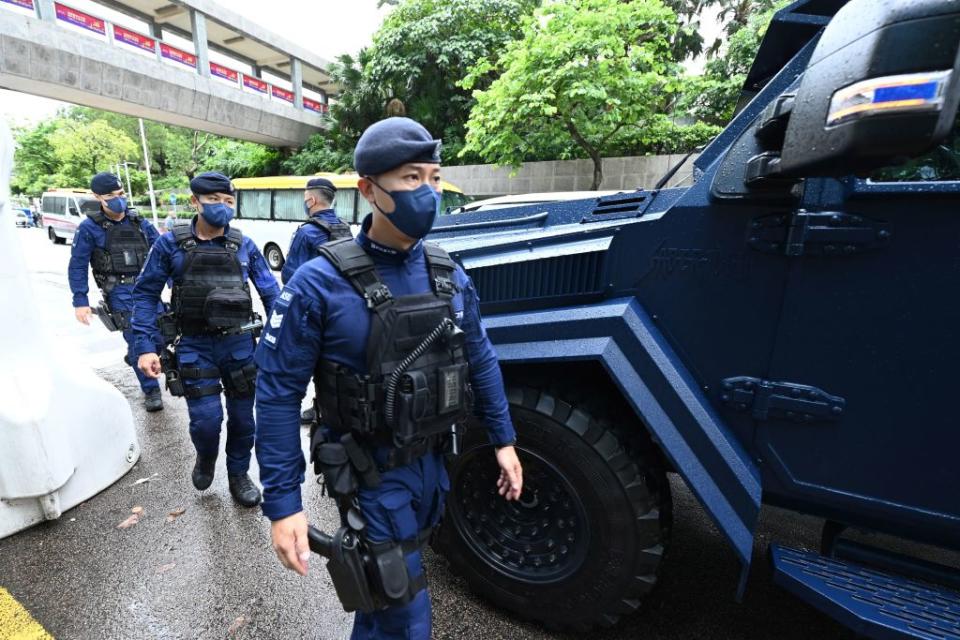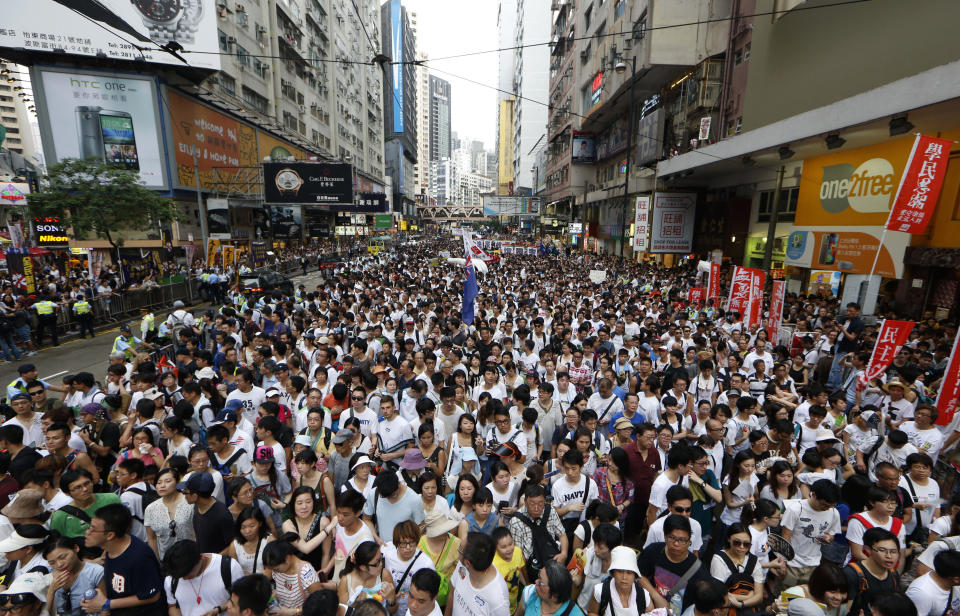'Reborn From the Ashes.' Xi Jinping Visits a Changed Hong Kong For Handover Anniversary

Hong Kong's new Chief Executive John Lee (L) walks off the stage with China's President Xi Jinping (R) following a swearing-in ceremony to inaugurate the city's new government in Hong Kong on July 1, 2022, on the 25th anniversary of the city's handover from Britain to China. Credit - Selim Chtayti—POOL/AFP/Getty Images
Neither the headwinds of an incoming typhoon nor a flurry of COVID-19 cases among government officials this week stopped Chinese President Xi Jinping from visiting Hong Kong to mark the 25th anniversary of the city’s July 1 return to Chinese rule, in a tightly choreographed visit intended to reinforce Beijing’s grip over the city.
Xi arrived by high-speed train on Thursday from the mainland tech metropolis Shenzhen, welcomed by supporters waving flags and signs with slogans like: “The Pearl of the Orient retains its romance. The city of vitality has become better than before.”
The trip is Xi’s first outside of mainland China since January 2020, when his zero-COVID policy slammed the country’s borders shut. It’s also his first visit to Hong Kong since hundreds of thousands took to the streets in 2019 anti-government protests, posing a challenge to Beijing’s rule of the special administrative region. In an ensuing crackdown, thousands have been arrested, opposition lawmakers have been jailed and newspapers and civil society groups have shut down.
“Hong Kong has withstood one severe challenge after another, and overcome one hazard after another,” he said in a brief speech when he arrived. “After the storm, Hong Kong has been reborn from the ashes, showing flourishing vitality.”
Experts say his visit is akin to a victory lap, to demonstrate that he has succeeded in remaking Hong Kong, at a time when questions have emerged over his stewardship of China over his zero-COVID policies and the Russian invasion of Ukraine. Xi is set to seek an unusual third term at party meetings in November.
“Xi needs to project success and is using his Hong Kong visit to showcase it,” says Steve Tsang, the director of SOAS China Institute at the University of London. “Xi is going to use his Hong Kong visit to project a magnificent achievement.”
Read More: The Rising Costs of China’s Zero-COVID Policy
Across the city, bright red Chinese flags that were hoisted for the visit whipped in the rain and wind as Typhoon Chaba edged closer to the city. Signs plastered on overpasses promise a new era of stability, prosperity and opportunity.
After his arrival Thursday, Xi visited Hong Kong Science Park, where several tech companies are based. He returned to the mainland Thursday night, before coming back to Hong Kong on Friday to attend the inauguration of the city’s new Chief Executive John Lee, who was handpicked by Beijing. Xi donned a face mask with the numbers “25” printed in red on it.
In a speech following Lee’s swearing in, he set out expectations for Lee’s administration, including solving deep-seated issues like housing. He also asked Hongkongers to accept “the mainstream values that are centered on love of the motherland and love of Hong Kong,” and said that Hong Kong people have “learned the hard way” that Hong Kong “cannot afford to see chaos.”

Hong Kong implemented a closed-loop bubble to keep COVID-19 at bay during the visit, putting thousands of government officials into hotel quarantine this week and requiring them to undergo rapid antigen tests. In recent weeks, several officials have tested positive and on Wednesday more than 2,000 cases were recorded for the first time since April.
Authorities were keen to ensure no disturbances occurred. Early in the week, six-foot water barriers were erected along the roads near the exhibition center where several key ceremonies are being hosted. Roads throughout Wan Chai, where most of the events are taking place, have been closed, snarling traffic across the city. The police presence in some neighborhoods like Causeway Bay appeared to be higher than normal this week. In the Central business district, the text on a large red sign on a sidewalk railing reminded passersby that anyone participating group gatherings of more than four people—regulations ostensibly in place to keep COVID-19 in check—will be fined or prosecuted.

At least 10 journalists were barred from attending the ceremonies, according to the Hong Kong Journalists Association (HKJA). The government said that coverage was limited due to “epidemic prevention needs, security requirements and venue restrictions.”
Prior to Xi’s crackdown on Hong Kong, protest marches were a normal occurrence on July 1. One of the last remaining pro-democracy groups in the city, the League of Social Democrats (LSD), said that they would not hold their normal protest on the 25th anniversary after some of its volunteers were summoned for meetings by the national security police, according to local news website Hong Kong Free Press (HKFP). The HKFP reported that police had searched the homes of several members of the LSD this week.
Other groups appeared to be treading carefully. The Hong Kong Public Opinion Research Institute said on June 28 that it was delaying the release of a survey about the handover “in response to suggestions” from the government.
Jeffrey Wasserstrom, the Chancellor’s Professor of History at U.C. Irvine and author of the book Vigil: Hong Kong on the Brink, tells TIME that Xi’s trip underscores the way Hong Kong has changed in recent years to become more like neighboring mainland cities—including his arrival at the West Kowloon High Speed Rail Station. The station sparked controversy in 2018 after the decision to have its security controlled by mainland personnel even though it is located in Hong Kong. The roads were lined with water barriers and activist groups were warned off in advance to ensure that there are no public expressions of discontent to compete with the official ceremonies on July 1.
“This is what routinely happens in mainland cities ahead of political anniversaries, such as National Day, but not what used to happen on July 1 in Hong Kong,” he says, “and did not happen there as recently as Xi’s last July visit in 2017.”

For much of the last 25 years, Hong Kong people fought to protect and increase the features of the city that made it different from the mainland like a freer press, more independent courts, and a government structure that, while far from fully democratic, had institutions where robust public debate on all sorts of topics could take place, says Wasserstrom. That was particularly true in the 2010s when moves to narrow the space between Hong Kong and the mainland were met with large-scale protests.
But that era appears to be over—despite a promise at the 1997 handover that Hong Kong would maintain a high level of autonomy for 50 years—following the clampdown on Hong Kong, and the implementation in 2020 of a national security law that has been used to crack down on dissent.
The changes in Hong Kong, Wasserstrom says, are “a trend that Beijing is pleased with but many local people pushed back against in protests of the 2010s and still find disturbing.”

 Yahoo Movies
Yahoo Movies 